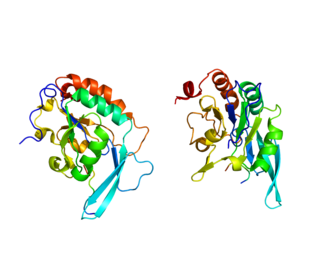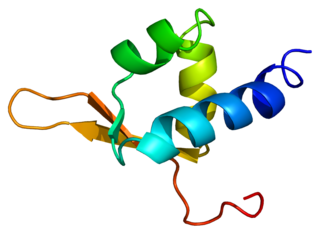Related Research Articles

General transcription factors (GTFs), also known as basal transcriptional factors, are a class of protein transcription factors that bind to specific sites (promoter) on DNA to activate transcription of genetic information from DNA to messenger RNA. GTFs, RNA polymerase, and the mediator constitute the basic transcriptional apparatus that first bind to the promoter, then start transcription. GTFs are also intimately involved in the process of gene regulation, and most are required for life.

The positive transcription elongation factor, P-TEFb, is a multiprotein complex that plays an essential role in the regulation of transcription by RNA polymerase II in eukaryotes. Immediately following initiation Pol II becomes trapped in promoter proximal paused positions on the majority of human genes. P-TEFb is a cyclin dependent kinase that can phosphorylate the DRB sensitivity inducing factor (DSIF) and negative elongation factor (NELF), as well as the carboxyl terminal domain of the large subunit of Pol II and this causes the transition into productive elongation leading to the synthesis of mRNAs. P-TEFb is regulated in part by a reversible association with the 7SK snRNP. Treatment of cells with the P-TEFb inhibitors DRB or flavopidirol leads to loss of mRNA production and ultimately cell death.

Cyclin-dependent kinase 9 or CDK9 is a cyclin-dependent kinase associated with P-TEFb.

DNA-directed RNA polymerase II subunit RPB1, also known as RPB1, is an enzyme that is encoded by the POLR2A gene in humans.

Elongin C is a protein that in humans is encoded by the ELOC gene.

Elongin B is a protein that in humans is encoded by the ELOB gene.

RNA polymerase II elongation factor ELL is an enzyme that in humans is encoded by the ELL gene.

Mediator of RNA polymerase II transcription subunit 21 is an enzyme that in humans is encoded by the MED21 gene.

Mediator of RNA polymerase II transcription subunit 6 is one of the subunits of the Mediator complex. It is an enzyme that in humans is encoded by the MED6 gene.

Elongin A is a protein that in humans is encoded by the ELOA gene.

Mediator of RNA polymerase II transcription subunit 8 is an enzyme that in humans is encoded by the MED8 gene.

General transcription factor IIF subunit 2 is a protein that in humans is encoded by the GTF2F2 gene.

Mediator of RNA polymerase II transcription subunit 26 is an enzyme that in humans is encoded by the MED26 gene. It forms part of the Mediator complex.

ELL-associated factor 2 is a protein that in humans is encoded by the EAF2 gene. It is part of the EAF family of proteins.

ELL-associated factor 1 is a protein that, in humans, is encoded by the EAF1 gene. It is part of the EAF family of proteins.
RNA polymerase II holoenzyme is a form of eukaryotic RNA polymerase II that is recruited to the promoters of protein-coding genes in living cells. It consists of RNA polymerase II, a subset of general transcription factors, and regulatory proteins known as SRB proteins.

Ali Shilatifard is an American biochemist, molecular biologist, the Robert Francis Furchgott Professor and chairman of the department of biochemistry and molecular genetics, and the director of the Simpson Query Institute for Epigenetics at the Northwestern University Feinberg School of Medicine. He has served as a member of the Senior Editorial Board for the journal Science. He also served as the founding Deputy Editor and the first academic Editor for Science's open access journal Science Advances between 2014 and 2023. During his tenure as the editor of Science Advances, the journal brought onboard roughly 50 deputy editors and over 350 associate editors managing over 22,000 annual submissions and roughly 2,000 annual publications, reaching an impact factor of 14.98. He has served on the Scientific Advisory Board (SAB) of Keystone Symposia, Max Planck Society, and Genentech and is a member of the jury for the BBVA Foundation Prize in Medicine.

Elongation factor RNA polymerase II-like 3 is a protein that in humans is encoded by the ELL3 gene.

Mediator complex subunit 19 (Med19) is a protein that in humans is encoded by the MED19 gene.

Elongation factor for RNA polymerase II 2 is a protein that in humans is encoded by the ELL2 gene.
References
- 1 2 Simone F, Polak PE, Kaberlein JJ, Luo RT, Levitan DA, Thirman MJ (July 2001). "EAF1, a novel ELL-associated factor that is delocalized by expression of the MLL-ELL fusion protein". Blood. 98 (1): 201–9. doi:10.1182/blood.V98.1.201. PMID 11418481. S2CID 2577367.
- 1 2 Polak PE, Simone F, Kaberlein JJ, Luo RT, Thirman MJ (April 2003). "ELL and EAF1 are Cajal body components that are disrupted in MLL-ELL leukemia". Mol. Biol. Cell. 14 (4): 1517–28. doi:10.1091/mbc.E02-07-0394. PMC 153119 . PMID 12686606.
- ↑ Kong SE, Banks CA, Shilatifard A, Conaway JW, Conaway RC (July 2005). "ELL-associated factors 1 and 2 are positive regulators of RNA polymerase II elongation factor ELL". Proc. Natl. Acad. Sci. U.S.A. 102 (29): 10094–8. Bibcode:2005PNAS..10210094K. doi: 10.1073/pnas.0503017102 . PMC 1177379 . PMID 16006523.
- ↑ Banks CA, Kong SE, Spahr H, Florens L, Martin-Brown S, Washburn MP, Conaway JW, Mushegian A, Conaway RC (February 2007). "Identification and Characterization of a Schizosaccharomyces pombe RNA Polymerase II Elongation Factor with Similarity to the Metazoan Transcription Factor ELL". J. Biol. Chem. 282 (8): 5761–9. doi: 10.1074/jbc.M610393200 . PMID 17150956.